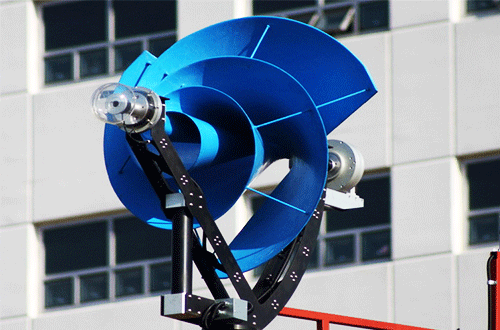Liam F1 นวัตกรรมกังหันลมสำหรับใช้ในครัวเรือน
POSTED ON 27/05/2557

ข่าวเทคโนโลยี - The Archimedes บริษัทวิจัยและพัฒนาซึ่งมีสำนักงานอยู่ที่เมืองรอตเทอร์ดาม ประเทศเนเธอร์แลนด์ ได้พัฒนากังหันลมรุ่นใหม่สำหรับการใช้งานภายในครัวเรือน โดยใช้ชื่อว่า Liam F1 Urban Wind Turbine ซึ่งสามารถผลิตกระแสไฟฟ้าจากลมได้มากกว่ากังหันลมรุ่นปัจจุบัน นอกจากนั้นยังมีดีไซน์ที่โดดเด่นจนทำให้แทบไม่มีเสียงดังรบกวน โดยบริษัทจะเปิดตัวนวัตกรรมดังกล่าวสู่สายตาสื่อมวลชนและสาธารณชนจากกว่า 40 ประเทศทั่วโลกในวันนี้
กังหันลม Liam F1 ผลิตกระแสไฟฟ้าได้เฉลี่ย 1,500 กิโลวัตต์-ชั่วโมง ที่ความเร็วลม 5 เมตร/วินาที ซึ่งคิดเป็นสัดส่วนถึงครึ่งหนึ่งของกระแสไฟฟ้าที่ใช้ในครัวเรือนทั่วไป และเมื่อใช้งานควบคู่กับแผงเซลล์แสงอาทิตย์บนหลังคาแล้ว ครัวเรือนจะสามารถพึ่งพาตนเองได้อย่างสมบูรณ์ในแง่ของการใช้ไฟฟ้า นายริชาร์ด รุยเตนบีค วิศวกรจาก The Archimedes อธิบายว่า “เมื่อมีลมคุณก็ใช้กังหันลมผลิตกระแสไฟฟ้า เมื่อมีแสงอาทิตย์คุณก็ใช้แผงเซลล์แสงอาทิตย์ผลิตไฟฟ้า”
ปัจจุบันกังหันลมสำหรับผลิตกระแสไฟฟ้าในครัวเรือนนั้นมีจำนวนน้อยมาก โดยส่วนหนึ่งเป็นเพราะผลผลิตกระแสไฟฟ้าจากกังหันลมรุ่นปัจจุบันอยู่ในระดับต่ำมาก (เฉลี่ย 25%) อีกทั้งเสียงใบพัดยังหนวกหูมากเกินไป นายมารินัส เมียร์เมต นักประดิษฐ์จาก The Archimedes จึงปรับปรุงดีไซน์ของกังหันลมด้วยการผสมผสานลักษณะของเปลือกหอยงวงช้างเข้ากับทฤษฎีของ The Archimedes และหลักคณิตศาสตร์ของเขาเอง ก่อกำเนิดเป็นกังหันลมรุ่นใหม่ที่แทบจะไม่มีแรงต้านและเสียงดังรบกวน
กังหันลม Liam ซึ่งมีรูปทรงบิดเป็นเกลียว จะปรับตำแหน่งลมให้เหมาะสมเหมือนธงสามเหลี่ยม ซึ่งจะก่อให้เกิดผลผลิตกระแสไฟฟ้าสูงสุด โดยนายเมียร์เมตเผยว่า ผลผลิตไฟฟ้าที่ได้นั้นคิดเป็น 80% ของผลผลิตสูงสุดเท่าที่เป็นไปได้ตามหลักทฤษฎี ทั้งนี้ กังหันลม Liam ผ่านการทดสอบมากกว่า 50 ครั้ง เนื่องจากตอนแรกเหล่านักพัฒนาไม่อยากจะเชื่อว่าผลลัพธ์ที่ได้จะดีขนาดนี้
แม้ว่าการเปิดตัวกังหันลมและการเปิดเผยหลักการทำงานจะเป็นที่ประจักษ์สู่สายตาในวันนี้ แต่ทางบริษัทฯ ได้จำหน่ายกังหันลมไปแล้วถึง 7,000 ต้น ใน 14 ประเทศ บริษัทฯ ได้รับกระแสตอบรับดีมากจนตัดสินใจเริ่มดำเนินการพัฒนากังหันลมขนาดเล็กสำหรับการใช้งานบนเรือ เสาไฟถนน และในน้ำ
The Rotterdam based research and development company "The Archimedes" reveals that it has developed a totally new generation of wind turbines for domestic use. This wind turbine will gain much more energy out of the wind than current generation wind turbines. Additionally this so-called Liam F1 Urban Wind Turbine hardly produces sound because of its remarkable design. The turbine will be presented to the press and people coming from over 40 countries on Tuesday.
The Liam F1 generates an average of 1,500 kilowatt-hour of energy at a wind-speed of 5m/s, which resembles half of the power consumption of a common household. In combination with solar-panels on the roof, a household could be totally self-supporting for its own energy needs. Engineer Richard Ruijtenbeek from The Archimedes explains that "when there is wind you use the energy produced by the wind turbine, when the sun is shining you use the solar cells to produce the energy".
At present there are very few wind turbines in use for generating energy in households. One of the reasons for his is that the yield from current generation wind turbines is very low (average of 25 percent), and that the blades produce too much noise. This is where the inventor of the Archimedes wind turbine, Marinus Mieremet, has adjusted the design. By combining the form of the Nautilus shell, the theoretics of Archimedes and his own mathematics, he created a new turbine that hardly has any resistance and has resulted in a design that is virtually soundless.
Because of its screw-form, the Liam will automatically aim to the optimal position of the wind, just like a pennant and will therefore have a maximum yield. According to Mieremet the yield is 80 percent of the maximum that is theoretically feasible. The Liam has been tested over 50 times because initially the developers couldn't believe the results they saw.
Although the revealing of the method and unveiling of the wind turbine will take place today, the company has already sold 7,000 turbines in 14 countries. The interest is so big that the company has started developing relatively small turbines for use on boats, on lampposts and in water.

